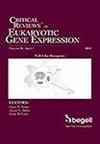lncRNA FTX的DNA甲基化依赖于DNMT1,可抑制肝细胞癌的铁变态反应
IF 1.6
4区 医学
Q4 BIOTECHNOLOGY & APPLIED MICROBIOLOGY
Critical Reviews in Eukaryotic Gene Expression
Pub Date : 2024-07-01
DOI:10.1615/critreveukaryotgeneexpr.2024054376
引用次数: 0
摘要
肝细胞癌(HCC)是全球恶性程度最高的实体瘤之一。长非编码 RNA(lncRNA)是导致 HCC 发病的关键因素。本研究旨在探讨 lncRNA FTX 在 HCC 中的作用。使用CCK-8和PI染色检测细胞功能。通过RNA荧光原位杂交(FISH)分析lncRNA FTX和DNMT1的位置。我们还使用了 RNA pulldown、RNA 免疫沉淀(RIP)和染色质免疫沉淀(ChIP)检测来确定相关机制。我们发现 FTX 在 HCC 患者中下调,这与预后不良有关。此外,DNMT1 介导的 FTX 启动子甲基化抑制了其表达。有趣的是,FTX 的过表达促进了 HCC 细胞的铁变态反应。FTX 疏导 miR-374b-3p 上调 TFRC 的表达。然而,下调 miR-374b-3p 或过表达 TFRC 可减轻 FTX 敲除的影响,并促进 HCC 细胞的存活。总之,依赖于 DNMT1 的 FTX DNA 甲基化通过调控 miR-374b-3p/TFRC 轴促进了 HCC 的发展。因此,DNMT1/FTX/miR-374b-3p/TFRC轴可能是治疗HCC的潜在靶点。本文章由计算机程序翻译,如有差异,请以英文原文为准。
DNMT1-dependent DNA methylation of lncRNA FTX inhibits the ferroptosis of hepatocellular carcinoma
Hepatocellular carcinoma (HCC) is one of the most malignant solid tumors worldwide. Long non-coding RNAs (lncRNAs) are the key factor in the pathogenesis of HCC. This study aimed to investigate the roles of lncRNA FTX in HCC. mRNA levels were detected using RT-qPCR. Protein expression was determined using western blot. cellular functions were determined using CCK-8 and PI staining assay. RNA fluorescent in situ hybridization (FISH) assay was conducted to analyze the location of lncRNA FTX and DNMT1. RNA pulldown, RNA immunoprecipitation (RIP), and chromatin-immunoprecipitation (ChIP) assays were used to ascertain the involved mechanisms. We found that FTX was downregulated in HCC patients, which was associated with poor prognosis. Moreover, DNMT1-mediated methylation of FTX promoter inhibited its expression. Interestingly, overexpression of FTX promoted the ferroptosis of HCC cells. FTX sponged miR-374b-3p to upregulate TFRC expression. However, downregulation of miR-374b-3p or overexpression of TFRC alleviated the effects of FTX knockdown and promoted the survival of HCC cells. In conclusion, DNMT1-dependent DNA methylation of FTX promotes the development of HCC through regulating miR-374b-3p/TFRC axis. Therefore, DNMT1/FTX/miR-374b-3p/TFRC axis may be a potential target for HCC.
求助全文
通过发布文献求助,成功后即可免费获取论文全文。
去求助
来源期刊

Critical Reviews in Eukaryotic Gene Expression
生物-生物工程与应用微生物
CiteScore
2.70
自引率
0.00%
发文量
67
审稿时长
1 months
期刊介绍:
Critical ReviewsTM in Eukaryotic Gene Expression presents timely concepts and experimental approaches that are contributing to rapid advances in our mechanistic understanding of gene regulation, organization, and structure within the contexts of biological control and the diagnosis/treatment of disease. The journal provides in-depth critical reviews, on well-defined topics of immediate interest, written by recognized specialists in the field. Extensive literature citations provide a comprehensive information resource.
Reviews are developed from an historical perspective and suggest directions that can be anticipated. Strengths as well as limitations of methodologies and experimental strategies are considered.
 求助内容:
求助内容: 应助结果提醒方式:
应助结果提醒方式:


